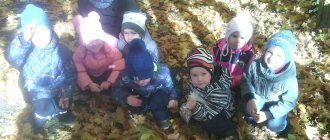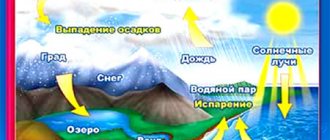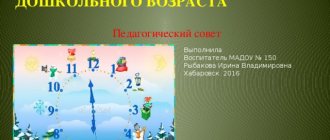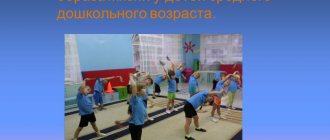Card index of experiments in the preparatory group
Experimentation at this age becomes more complex and improved. Carrying out independent experimental work, children look for the optimal way to carry it out. In addition to the environment, the children explore human activity, the topic of physical experiments expands, and work begins in the kitchen. An approximate card index of experimental topics, designed for the older group:
- Space – 4 lessons;
- Ecology – 8 lessons;
- Air – 3 lessons;
- Person – 5 lessons;
- Temperature - 5 classes;
- Physical experiments - 5 lessons;
- Experiments in the kitchen – 3 lessons.
During experimentation, children can keep personal notebooks where they record the results of their experiments. In her work, the teacher uses cue cards and pictures with fairy-tale characters.
Card index of experiments in the senior group according to the Federal State Educational Standard
Educational standards provide for the comprehensive development of the child’s personality. Experimentation in the older group is aimed at stimulating independent exploration of actions, phenomena and objects. To facilitate research work, special diagrams and models with a detailed algorithm of actions are placed in the experimental corner. Educational books, atlases and various collections from natural materials can serve as a supplement.
An approximate card index of experimental topics, designed for the older group:
- Space – 5 lessons;
- Water – 4 lessons;
- Air – 6 lessons;
- Sand – 5 lessons;
- Plants and animals – 13 lessons;
- Temperature - 5 classes;
- Magnetism – 3 lessons.
Experiments and experiments preparatory group
It is advisable to carry out experimental activities at home with parents. By experimenting, little inventors learn the most complex laws of nature and grow into creative individuals.
Card file of experiences and experiments in kindergarten, junior group
Children in the younger group perceive experimental activities best in a playful way. It is during this period that the ability to explore new objects is laid. Kids quickly get involved in the game and with great pleasure build with sand, watch the formation of frost and the immersion of objects in water. Thus, the child learns the properties of materials and works on fine motor skills. Experimentation is carried out to solve a specific situation. The teacher sets a problem and, together with the children, tries to solve it in a playful way. At the end of the study, the guys must draw a certain conclusion. For example, is it possible to lick an icicle, eat snow, make a pie out of sand, etc. Experimentation is carried out in a special corner or while walking on the street.
An approximate catalog of experimental topics designed for the younger group:
- Natural materials – 8 lessons;
- Water – 6 lessons;
- Air – 4 lessons;
- Sand – 4 lessons;
- Paper – 4 lessons;
- Fabric – 3 lessons.
Important! Experimentation at a younger age should not last more than 15 minutes.
Experiments and experiments junior group
"Shadow Formation"
Task: Getting to know the shadow, its appearance and dependence on the object and light.
Process:
- Go for a walk and watch the shadows form on the street. Pay attention to trees, shrubs and flowers. Determine the size of the shadow and its degree of strength.
- Play a shadow theater with the kids. Show that transparent objects do not form a shadow, because light passes through them. If you point multiple light sources at an object, you can get multiple shadows.
Conclusion: A shadow is a dark spot that appears along with a light source. Light rays hitting an obstacle are refracted and move to the floor or wall in the form of a dark spot.
"Properties of Water"
Objective: Getting to know water and its properties.
Process: Children work with two glasses. One contains water, which must be poured into an empty glass. Explain to the children that water is a liquid that pours from a tap and flows in a river. For example, show jelly, which pours thicker and heavier.
Conclusion: Water is in liquid form, so it flows easily.
"Properties of Water"
Objective: Continued acquaintance with the properties of water.
Process: Children pour water into transparent vessels of different shapes. Pay attention to the fact that when the liquid enters the vessel, it takes on its shape.
Conclusion: Water has a liquid form and easily takes the shape of a vessel.
"Properties of sand"
Task: Getting to know the properties of sand.
Process: Children look at two glasses. One is filled with water, the other is filled with sand. Let them touch both substances with their fingers. Pay attention to the fact that the water is wet and the sand is dry and consists of small grains of sand. Invite the children to pour water into the sand.
Conclusion: Sand is free-flowing and quickly absorbs liquid.
"Experiments with paper"
Task: Getting to know paper and its properties.
Process: Children tear the paper into small pieces, crumple them into lumps and make an applique out of them. Draw the outlines of the drawing in advance with a marker. Draw children's attention to what sounds the sheet makes when torn and compressed.
Conclusion: The paper tears easily and quickly crumples into lumps. She is easy to work with.
Experiments in the middle group card index with goals
Free experimentation, which was carried out in the younger group, provided for the children to act along an intuitive path; in middle age, experiments are planned according to a specific plan:
- setting a specific task;
- children making assumptions;
- joint testing of hypotheses;
- recording the results and summing up.
Important! The experimental card index for the middle group is constantly updated and formed strictly according to sections.
An approximate card index of experimental topics, designed for the average group:
- Space – 3 lessons;
- Water – 7 lessons;
- Air – 4 lessons;
- Sand – 6 lessons;
- Plants – 12 lessons;
- Temperature - 3 classes;
- Animals – 3 lessons.
| Subjects | Target | Contents of the experiment |
| "Sand" | To consolidate knowledge about the properties of wet and dry sand. |
|
| "Water: different forms" | Give an idea of the properties of water. |
|
| " Animals" | Develop tactile-kinesthetic sensitivity. |
|
| "Temperature" | To develop in children the ability to determine the temperature of water. |
|





